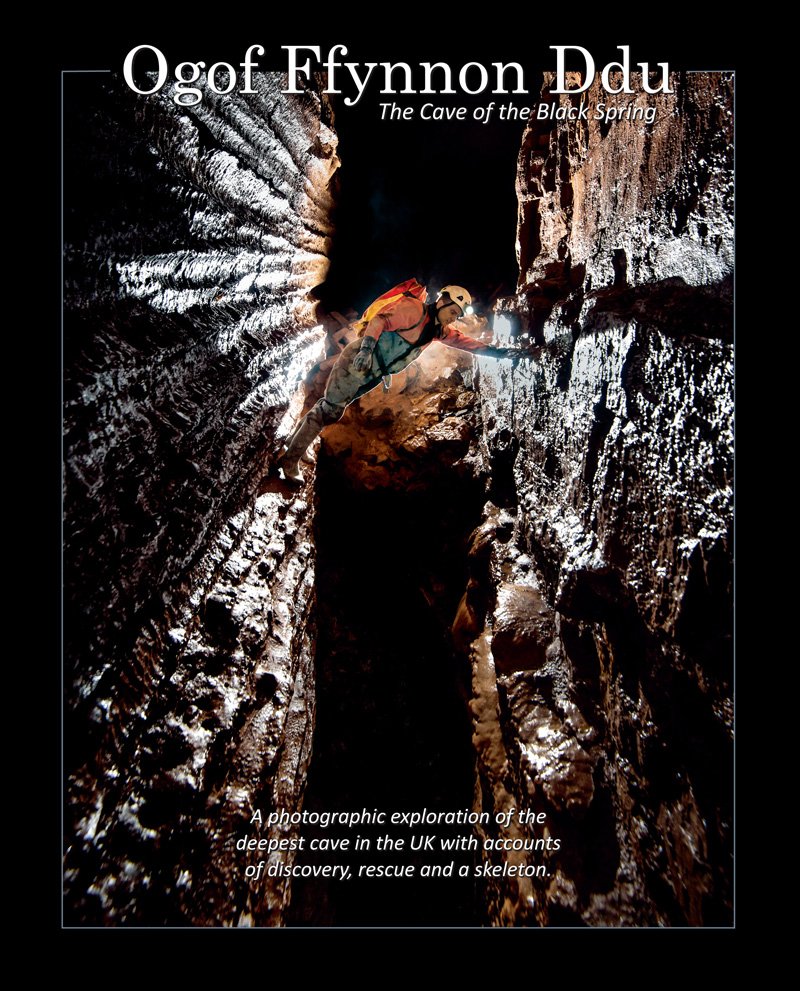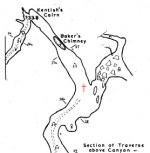andrewmcleod
Well-known member
(the bit where I talk about caving instead of faff, or at least caving as well as faff, starts about five paragraphs down)
EUSS go to Eastwater Cavern, 11th December 2016
With a nearly catastrophic and total lack of drivers the Exeter University Speleological Society Christmas trip to Yorkshire was cut back to the Mendips and nearly cancelled entirely. Fortunately it turned out I could drive, despite other weekend commitments, and we met up at the tackle store at the agreed 5pm to head off to the Mendips, with the party consisting of me, our glorious leader Ari, former leader Ed, secretary Holly and fresher Brieuc.
Or at least that was the plan. This being an EUSS trip, faff occurred and we arrived at the Belfry after 9pm despite it being just short of a two hour drive. Nonetheless the fire was started and the party began, along with some OUCC cavers and a lone A+E caver. I had an early start the next day so I went to bed at 1:30am, but the party continued till at least 5am. I can neither confirm nor deny that some naked caving occurred (since I was in bed).
At 6:30am I dragged myself out of bed and drove to South Wales to shoot people with paintballs at my brother?s stag do. Meanwhile EUSS nursed their hangovers and went round GB. I eventually left the stag do, picking up one of our members on the way from a nightclub in Bristol at 2:30am, and drove through the dense fog covering the Mendips back to the Belfry.
In the morning, we slept. In the early afternoon, we got up and readied ourselves for Eastwater Cavern and the Thirteen Pots. Our somewhat late start, with many of us suffering from a combination of hangovers, sleep deprivation and whatever virus is currently doing the rounds, meant we arrived at the cave at around 2:40pm.
Last year?s assault on Eastwater ended with a rather embarrassing episode involving a large slow party, 15 minutes the wrong side of a callout, three fire engines, one police car, one ambulance, MRO and a lot of apologies ? something we would not be repeating. This time I had a watch! (and we had a much later callout).
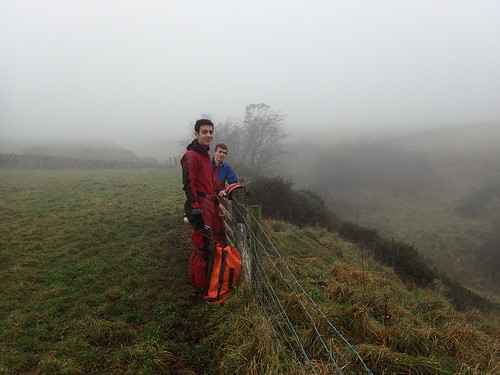
We arrived at the lovely little blind valley that the Eastwater stream runs down. It was pretty foggy but dry and there was no water running into the entrance. Eastwater begins as it means to go on ? as a horrendous nightmare of a cave where absolutely nothing is ever easy. The descent into the entrance boulder ruckle is not really that hard, but you are (or should be) constantly aware of the hanging death in all directions should you leave the safety of the guide lines?
A bit of a theme in Eastwater is that the nicest part of any element of the cave is the bit where you get to stop doing it. This is certainly true of the boulder ruckle but sadly it leads immediately to the legendary Upper Traverse; the steeply angled and tight bedding plane across which one must traverse, passing through a few eyeholes along the way. Last year we had ended up at the chamber with the little cross dedicated to (Private?) Kentish, which I assumed was at the point on the survey marked Kentish?s Cairn, and so I also assumed we had taken in the dark blue route on the MU5 survey to reach it. At the time I had no idea how we had ended up there.
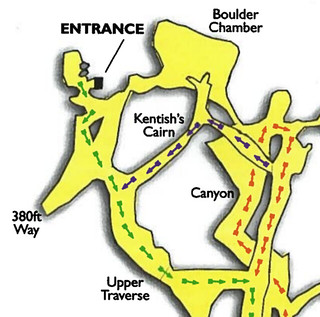
(credit: Mendip Underground)
This time, as we entered the Upper Traverse I saw the tight rising bedding plane of the Kentish?s Cairn route on the left as we passed it, continuing down the Upper Traverse. However, the traverse began to look strangely familiar? When we reached the T-junction in the bedding plane my request to turn right and go down to Hallelujah Hole were denied by our glorious leader struggling with a tackle sack, and so instead we headed left and uphill to? Kentish?s Cairn (or at least the chamber with the cross). I was as baffled as I was last year.
Eastwater has a habit of confusing and bewildering you, given that the Thirteen Pots trip is essentially a complicated series of spirals. Finally I realised that that we had done exactly the same thing as last year and that the little cross is not where it says ?Kentish?s Cairn? on the survey. Instead (I think) what we did is the normal route. We then dropped down what I assume is the Baker?s Chimney Bypass and headed down the Canyon. This year I went down the left route (the Slide), looking downhill, sliding down on top of the bedding plane rather than climbing down the trench of the canyon itself, and rapidly arriving at the Crossroads, clearly indicated by the road sign with ?Crossroads? written on it.
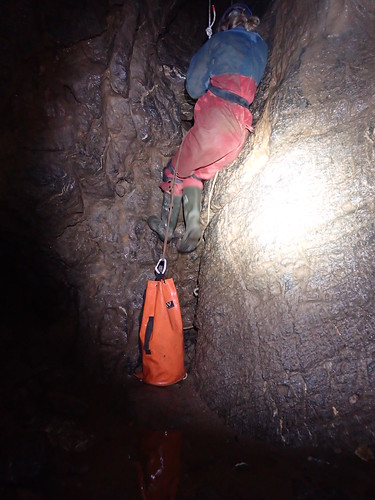
Here, left down the tube takes you to Dolphin Pot. I had decided to make this both easy and safe as possible so I brought a pair of 15m ropes: one for a handline and one for a lifeline for everyone except the last person down and the first person up since there (probably?) isn?t enough rope for a double lifeline.
It is another of those perverse quirks of Eastwater than you have to drag your tackle sack full of a ladder and ropes through most of the difficult bits of the cave, but it is still nice when you get to the head of the 35ft pitch and can leave it behind. I rigged this using a 15m rope, starting around the enormous thread in the chamber then running the rope through to the dubious pair of bolts with rusting maillons and loose hangars. Thoroughly unconvinced by either, I finally tied the rope off to the boulder at the pitch head and hung the ladder.
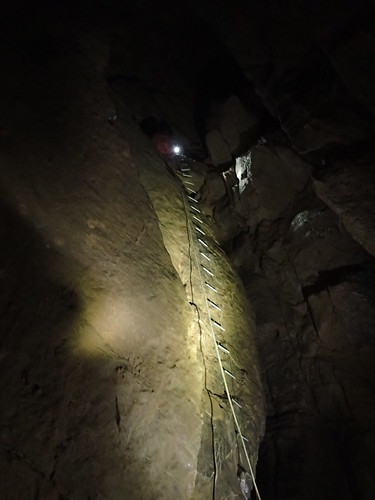
As usual, I missed the large pair of eyebolts of unknown vintage high up on one side, but given the total lack of wear below the bolts so does everyone else. It would be very difficult to back these up sensibly as they are too high to use the rope from the main chamber. I wouldn?t complain if anyone wanted to knock a pair of P-bolts in the ceiling? I then headed down the ladder while being lifelined directly off the thread in the main chamber. The rest of us came down double-lifelining from the bottom of the pitch through a crab hung just over the edge.
Now, just for variety, we have to shuffle across a steeply inclined bedding plane. This rapidly opens up into a canyon, Harris?s Passage, which is actually the same feature as the 13 Pots but is blocked half-way, and so we clamber across to the Second Bold Step ? the first having collapsed long ago, apparently.
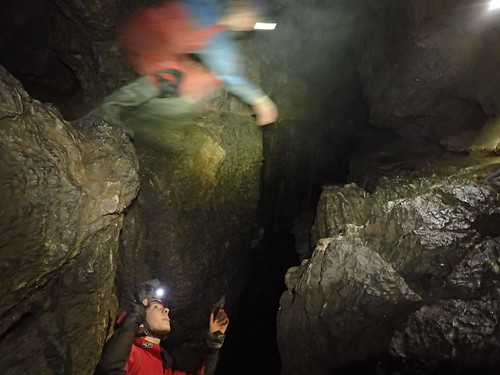
Last year I refused to jump across, instead climbing down a bit, stepping across and then climbing up, but this year with better welly boots I went for the jump. The bold step is definitely one of those features where falling could go either badly, if you hit stuff on the way down, or very badly, if you missed the stuff in the way and dropped either to the bottom of the Second Vertical or the deepish hole the other way! Fortunately I did neither of those things, and we continued down the Muddy Oxbow until we arrived at the bottom of the Thirteen Pots.
Having done the Pots in the easier downward direction last time, I was keen to try upwards. I have heard it described as a series of short boulder problems, and indeed it was great fun ? almost worth dragging yourself through the rest of the cave for. We soon arrived back at the Bold Step and began our return journey.
In Eastwater, because the bedding is fairly steep, you tend to be losing or gaining significant height with little horizontal progress. This makes the return journey quite hard work, as you are continuously clambering upwards. We climbed Harris? Passage, climbed and derigged the 35ft Pitch and Dolphin Pot, ascended the Canyon and ended up once more at the chamber where the Baker?s Chimney Bypass pops out. I also decided that a vague aven above was probably Baker?s Chimney.
At this point certain members of the party decided to poke their heads in a small hole which I had earlier identified as likely to be the Wind Tunnel, and indeed they soon found themselves in Boulder Chamber. I had been repeating the graphic warnings in MU5 about the looseness of Boulder Chamber to everyone who stood still long enough, and so some of the members of the party were keen to leave, but the route in from Wind Tunnel is supposed to be stable enough. We had a poke around looking for polish and the Woggle Press, but headed back out via the Wind Tunnel rather than taking the more risky option..
I also declared that an aven on one side of Boulder Chamber must be Baker?s Chimney. ?If you say it enough times it might be true?, opined Ari. As we headed back through the Wind Tunnel, I looked up, saw a much more likely rifty aven thing and declared that that was, instead, Baker?s Chimney.
Once back in the chamber, I saw another upwards-heading thing and declared that that was Baker?s Chimney. At this point we decided to try the shortcut via Kentish Cairn to avoid repeating the Upper Traverse, and so climbed the Baker?s Chimney Bypass and returned to the chamber containing the cross. We then headed in the only remaining direction only to find? Baker?s Chimney, this time dropping down below us. Since this perfectly matched the description which states that the route traverses over the top of it, finally the question of the location of Baker?s Chimney was answered.
Or was it? For no sooner than we crossed this hole than another appeared? which one (or both) is Baker?s Chimney? This is a question that we will have to answer another day. Regardless of this conundrum, we continued onwards until we saw the bedding plane dropping away to the left. This was comforting, since the other way on here is supposed to drop directly into the roof of Boulder Chamber and certain loose hanging death. I slung my tackle sack below me and began pleasantly sliding down the steep, tight bedding plane.
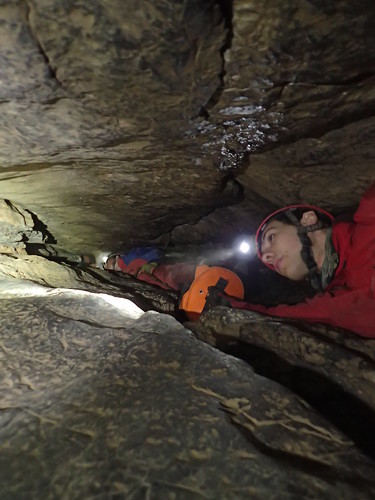
Now, I expect precisely as much sympathy for this as I give to taller climbers when they complain that a move is awkward for them because they are too tall (i.e. no sympathy whatsoever), but in this case I was just a bit too thin. This meant I could slide down slightly the wrong bit of the bedding plane, while my tackle sack quite wisely found the right part, dropped into the start of the trench and got stuck. This was a conundrum, since in order to progress I needed to be in the trench currently occupied by my tackle sack, upward progress was rather difficult, and in order to free my tackle sack (by giving it a boot in the right place) I needed to be able to move a bit more, which I couldn?t because I was slightly too far to the left.
Ari asked me if I was alright. I replied that I was but I was having a quick moment of contemplation. He asked if I needed any help; I responded that I did not, but I might do in twenty minutes or so?
Fortunately with a bit of determined wiggling, I was able to get to the wider bit above my bag, kick the bag out from where it was stuck and get into the much larger bit of the trench and proceed onwards. Briefly unnerving, but a significant shortcut compared to going around the whole Upper Traverse and probably quite pleasant if there isn?t a bag in your way! The other bag was guided down from below to avoid a repeat of the incident.
We regrouped, daring once again to pass through the Boulder Ruckle and emerged into darkness and thick fog just under five hours after entering the cave ? significantly faster than our last attempt. However, no EUSS trip to Eastwater ever goes quite as planned, and what followed was one of the finest pieces of navigational failure EUSS have ever achieved. Below is satellite imagery showing Eastwater, and the footpath across the field which is (probably) the quickest way back to the Belfry.
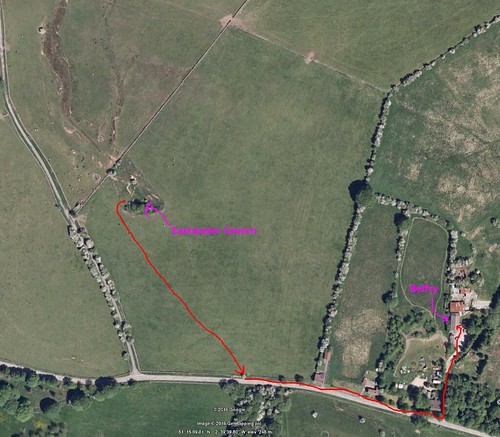
Unfortunately, an overly hasty departure meant that we never actually ended up on the footpath, and instead started following vague disappearing tracks until we hit a house, rather than the road we were expecting. At this point disaster could have been averted if we had listened more seriously to the opinion of our Glorious Leader, but unfortunately we decided that the only safe way to proceed was to follow the wall. In the wrong direction. Consequently, we walked around the perimeter of the field until we hit Eastwater again, and were back where we started. At this point we should have found, and walked down, the footpath, but a decision was made that it was safest to head in the direction of the Wessex, get onto Eastwater Lane, and walk along the road.
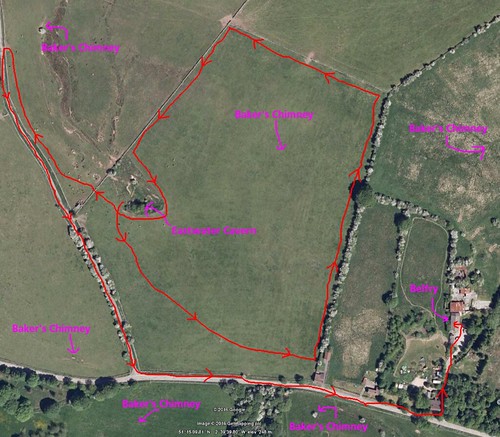
None of use really remembered that you have to walk quite a way towards the Wessex before you can actually cross the wall onto Eastwater Lane, adding considerably to the already outrageously extended walk back to the hut. But eventually we regained the road, walked back along it and stumbled into the Belfry.
You do not conquer Eastwater; you only survive it. Some members have dreams of one day completing the grade 5 Southbank Round Trip, but even the relatively short grade 3 Thirteen Pots trip remains a significant challenge. Eastwater punishes hubris; it gives nothing easily and makes you work for every metre, while befuddling your senses with its endless spirals upwards or downwards. Horrific cave, but great cave
Where will EUSS?s adventures in vaguely successful incompetency take them next? Will they once again get lost in fog? Will they even find the cave? Will they ever work out what Baker?s Chimney is? Tune in next year!
PS photos this time! I have bought myself a TG4 as a Christmas present; didn't have time to use it properly and didn't have a tripod to try Live Composite properly, but hopefully future trip reports will be a bit more illustrated...
EUSS go to Eastwater Cavern, 11th December 2016
With a nearly catastrophic and total lack of drivers the Exeter University Speleological Society Christmas trip to Yorkshire was cut back to the Mendips and nearly cancelled entirely. Fortunately it turned out I could drive, despite other weekend commitments, and we met up at the tackle store at the agreed 5pm to head off to the Mendips, with the party consisting of me, our glorious leader Ari, former leader Ed, secretary Holly and fresher Brieuc.
Or at least that was the plan. This being an EUSS trip, faff occurred and we arrived at the Belfry after 9pm despite it being just short of a two hour drive. Nonetheless the fire was started and the party began, along with some OUCC cavers and a lone A+E caver. I had an early start the next day so I went to bed at 1:30am, but the party continued till at least 5am. I can neither confirm nor deny that some naked caving occurred (since I was in bed).
At 6:30am I dragged myself out of bed and drove to South Wales to shoot people with paintballs at my brother?s stag do. Meanwhile EUSS nursed their hangovers and went round GB. I eventually left the stag do, picking up one of our members on the way from a nightclub in Bristol at 2:30am, and drove through the dense fog covering the Mendips back to the Belfry.
In the morning, we slept. In the early afternoon, we got up and readied ourselves for Eastwater Cavern and the Thirteen Pots. Our somewhat late start, with many of us suffering from a combination of hangovers, sleep deprivation and whatever virus is currently doing the rounds, meant we arrived at the cave at around 2:40pm.
Last year?s assault on Eastwater ended with a rather embarrassing episode involving a large slow party, 15 minutes the wrong side of a callout, three fire engines, one police car, one ambulance, MRO and a lot of apologies ? something we would not be repeating. This time I had a watch! (and we had a much later callout).

We arrived at the lovely little blind valley that the Eastwater stream runs down. It was pretty foggy but dry and there was no water running into the entrance. Eastwater begins as it means to go on ? as a horrendous nightmare of a cave where absolutely nothing is ever easy. The descent into the entrance boulder ruckle is not really that hard, but you are (or should be) constantly aware of the hanging death in all directions should you leave the safety of the guide lines?
A bit of a theme in Eastwater is that the nicest part of any element of the cave is the bit where you get to stop doing it. This is certainly true of the boulder ruckle but sadly it leads immediately to the legendary Upper Traverse; the steeply angled and tight bedding plane across which one must traverse, passing through a few eyeholes along the way. Last year we had ended up at the chamber with the little cross dedicated to (Private?) Kentish, which I assumed was at the point on the survey marked Kentish?s Cairn, and so I also assumed we had taken in the dark blue route on the MU5 survey to reach it. At the time I had no idea how we had ended up there.

(credit: Mendip Underground)
This time, as we entered the Upper Traverse I saw the tight rising bedding plane of the Kentish?s Cairn route on the left as we passed it, continuing down the Upper Traverse. However, the traverse began to look strangely familiar? When we reached the T-junction in the bedding plane my request to turn right and go down to Hallelujah Hole were denied by our glorious leader struggling with a tackle sack, and so instead we headed left and uphill to? Kentish?s Cairn (or at least the chamber with the cross). I was as baffled as I was last year.
Eastwater has a habit of confusing and bewildering you, given that the Thirteen Pots trip is essentially a complicated series of spirals. Finally I realised that that we had done exactly the same thing as last year and that the little cross is not where it says ?Kentish?s Cairn? on the survey. Instead (I think) what we did is the normal route. We then dropped down what I assume is the Baker?s Chimney Bypass and headed down the Canyon. This year I went down the left route (the Slide), looking downhill, sliding down on top of the bedding plane rather than climbing down the trench of the canyon itself, and rapidly arriving at the Crossroads, clearly indicated by the road sign with ?Crossroads? written on it.

Here, left down the tube takes you to Dolphin Pot. I had decided to make this both easy and safe as possible so I brought a pair of 15m ropes: one for a handline and one for a lifeline for everyone except the last person down and the first person up since there (probably?) isn?t enough rope for a double lifeline.
It is another of those perverse quirks of Eastwater than you have to drag your tackle sack full of a ladder and ropes through most of the difficult bits of the cave, but it is still nice when you get to the head of the 35ft pitch and can leave it behind. I rigged this using a 15m rope, starting around the enormous thread in the chamber then running the rope through to the dubious pair of bolts with rusting maillons and loose hangars. Thoroughly unconvinced by either, I finally tied the rope off to the boulder at the pitch head and hung the ladder.

As usual, I missed the large pair of eyebolts of unknown vintage high up on one side, but given the total lack of wear below the bolts so does everyone else. It would be very difficult to back these up sensibly as they are too high to use the rope from the main chamber. I wouldn?t complain if anyone wanted to knock a pair of P-bolts in the ceiling? I then headed down the ladder while being lifelined directly off the thread in the main chamber. The rest of us came down double-lifelining from the bottom of the pitch through a crab hung just over the edge.
Now, just for variety, we have to shuffle across a steeply inclined bedding plane. This rapidly opens up into a canyon, Harris?s Passage, which is actually the same feature as the 13 Pots but is blocked half-way, and so we clamber across to the Second Bold Step ? the first having collapsed long ago, apparently.

Last year I refused to jump across, instead climbing down a bit, stepping across and then climbing up, but this year with better welly boots I went for the jump. The bold step is definitely one of those features where falling could go either badly, if you hit stuff on the way down, or very badly, if you missed the stuff in the way and dropped either to the bottom of the Second Vertical or the deepish hole the other way! Fortunately I did neither of those things, and we continued down the Muddy Oxbow until we arrived at the bottom of the Thirteen Pots.
Having done the Pots in the easier downward direction last time, I was keen to try upwards. I have heard it described as a series of short boulder problems, and indeed it was great fun ? almost worth dragging yourself through the rest of the cave for. We soon arrived back at the Bold Step and began our return journey.
In Eastwater, because the bedding is fairly steep, you tend to be losing or gaining significant height with little horizontal progress. This makes the return journey quite hard work, as you are continuously clambering upwards. We climbed Harris? Passage, climbed and derigged the 35ft Pitch and Dolphin Pot, ascended the Canyon and ended up once more at the chamber where the Baker?s Chimney Bypass pops out. I also decided that a vague aven above was probably Baker?s Chimney.
At this point certain members of the party decided to poke their heads in a small hole which I had earlier identified as likely to be the Wind Tunnel, and indeed they soon found themselves in Boulder Chamber. I had been repeating the graphic warnings in MU5 about the looseness of Boulder Chamber to everyone who stood still long enough, and so some of the members of the party were keen to leave, but the route in from Wind Tunnel is supposed to be stable enough. We had a poke around looking for polish and the Woggle Press, but headed back out via the Wind Tunnel rather than taking the more risky option..
I also declared that an aven on one side of Boulder Chamber must be Baker?s Chimney. ?If you say it enough times it might be true?, opined Ari. As we headed back through the Wind Tunnel, I looked up, saw a much more likely rifty aven thing and declared that that was, instead, Baker?s Chimney.
Once back in the chamber, I saw another upwards-heading thing and declared that that was Baker?s Chimney. At this point we decided to try the shortcut via Kentish Cairn to avoid repeating the Upper Traverse, and so climbed the Baker?s Chimney Bypass and returned to the chamber containing the cross. We then headed in the only remaining direction only to find? Baker?s Chimney, this time dropping down below us. Since this perfectly matched the description which states that the route traverses over the top of it, finally the question of the location of Baker?s Chimney was answered.
Or was it? For no sooner than we crossed this hole than another appeared? which one (or both) is Baker?s Chimney? This is a question that we will have to answer another day. Regardless of this conundrum, we continued onwards until we saw the bedding plane dropping away to the left. This was comforting, since the other way on here is supposed to drop directly into the roof of Boulder Chamber and certain loose hanging death. I slung my tackle sack below me and began pleasantly sliding down the steep, tight bedding plane.

Now, I expect precisely as much sympathy for this as I give to taller climbers when they complain that a move is awkward for them because they are too tall (i.e. no sympathy whatsoever), but in this case I was just a bit too thin. This meant I could slide down slightly the wrong bit of the bedding plane, while my tackle sack quite wisely found the right part, dropped into the start of the trench and got stuck. This was a conundrum, since in order to progress I needed to be in the trench currently occupied by my tackle sack, upward progress was rather difficult, and in order to free my tackle sack (by giving it a boot in the right place) I needed to be able to move a bit more, which I couldn?t because I was slightly too far to the left.
Ari asked me if I was alright. I replied that I was but I was having a quick moment of contemplation. He asked if I needed any help; I responded that I did not, but I might do in twenty minutes or so?
Fortunately with a bit of determined wiggling, I was able to get to the wider bit above my bag, kick the bag out from where it was stuck and get into the much larger bit of the trench and proceed onwards. Briefly unnerving, but a significant shortcut compared to going around the whole Upper Traverse and probably quite pleasant if there isn?t a bag in your way! The other bag was guided down from below to avoid a repeat of the incident.
We regrouped, daring once again to pass through the Boulder Ruckle and emerged into darkness and thick fog just under five hours after entering the cave ? significantly faster than our last attempt. However, no EUSS trip to Eastwater ever goes quite as planned, and what followed was one of the finest pieces of navigational failure EUSS have ever achieved. Below is satellite imagery showing Eastwater, and the footpath across the field which is (probably) the quickest way back to the Belfry.

Unfortunately, an overly hasty departure meant that we never actually ended up on the footpath, and instead started following vague disappearing tracks until we hit a house, rather than the road we were expecting. At this point disaster could have been averted if we had listened more seriously to the opinion of our Glorious Leader, but unfortunately we decided that the only safe way to proceed was to follow the wall. In the wrong direction. Consequently, we walked around the perimeter of the field until we hit Eastwater again, and were back where we started. At this point we should have found, and walked down, the footpath, but a decision was made that it was safest to head in the direction of the Wessex, get onto Eastwater Lane, and walk along the road.

None of use really remembered that you have to walk quite a way towards the Wessex before you can actually cross the wall onto Eastwater Lane, adding considerably to the already outrageously extended walk back to the hut. But eventually we regained the road, walked back along it and stumbled into the Belfry.
You do not conquer Eastwater; you only survive it. Some members have dreams of one day completing the grade 5 Southbank Round Trip, but even the relatively short grade 3 Thirteen Pots trip remains a significant challenge. Eastwater punishes hubris; it gives nothing easily and makes you work for every metre, while befuddling your senses with its endless spirals upwards or downwards. Horrific cave, but great cave
Where will EUSS?s adventures in vaguely successful incompetency take them next? Will they once again get lost in fog? Will they even find the cave? Will they ever work out what Baker?s Chimney is? Tune in next year!
PS photos this time! I have bought myself a TG4 as a Christmas present; didn't have time to use it properly and didn't have a tripod to try Live Composite properly, but hopefully future trip reports will be a bit more illustrated...

